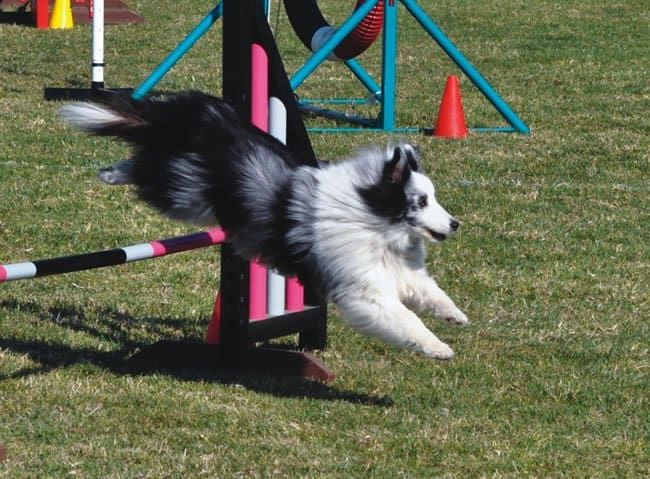Your dog’s skin is the largest organ in his body and is comprised of multiple layers. The inner layer protects the internal organs and blood vessels, while the outer layer sheds old cells and secretes oils into the hair follicles, providing shine and water resistance.
Although it sounds like a simple organ, it’s not. Tiny problems can get out of control, requiring long therapies to heal. And when skin problems arise, it can be difficult and time-consuming to determine exactly what caused the problem. It’s no wonder skin ailments are one of the most common reasons dogs are taken to their veterinarians.
Keeping your dog’s skin healthy is critical to his hair coat health, too. The initial symptom of many health issues is often a dull, flat coat. While this is sometimes a matter of poor grooming, it can also be caused by a health issue. A dog who constantly scratches may be battling parasites, food allergies/sensitivities, or adrenal problems, such as Cushing’s syndrome.
Dry skin is nothing to blow off. It’s not just a matter of comfort. If your dog’s skin isn’t moist and pliable, it can crack, providing an entry point for microorganisms like bacteria or fungi. Dry-skin solutions may be as simple as correcting a dietary imbalance or using a conditioner after a bath. But you need to be aware that it could also indicate a thyroid problem or a parasite infestation. A trip to the veterinarian is in order if your dog’s itching does not subside with simple topical treatments.
Fortunately, prevention goes a long way toward avoiding that vet call, so let’s move on to the 10 steps to ensure your dog’s coat is glossy, silky, and healthy:
1. Optimize Nutrition. Feeding a top-quality commercial dog food or well-formulated, home-prepared diet will ensure your dog receives the nutrients he needs. Avoid foods containing low-quality fat sources (such as plant-sourced oils or “animal fat”). If your dog is allergic to or intolerant of certain ingredients, check ingredient labels carefully each time you buy a commercial food; the manufacturer may have changed the formula and added the problematic (for your dog) ingredient.
2. Consider a Supplement – Your dog may need a little extra nutrition support in the form of the omega 3 fatty acids EPA and DHA. Adding a fish-oil supplement to your dog’s diet is the best way to provide these powerful anti-inflammatory nutrients. Only fresh oils should be used; never feed oils that smell rancid or “off.” All oils are fats and provide about 40 calories per teaspoon, so amounts should be limited, particularly in overweight dogs and those already eating a high-fat diet.
3. Establish a Regular Grooming Schedule. While long-haired dogs like Shetland Sheepdogs require more frequent brushing than short-haired Labradors, a weekly session is a good rule of thumb for most. Balance the frequency with the dog’s activity. Dogs who run through long grasses may get burrs that should be removed immediately (or he’ll chew them out!), and mud and dirt should be brushed out of their coats right away. City-dwelling dogs who walk through manicured parks usually need less attention, but watch for matting, especially in sensitive places, such as behind the ears and between the legs. Remember, too, that very young and very old dogs often do better with several shorter sessions a week rather than a single long one.
4. Choose the Right Grooming Tool. You’ll find no shortage of dog-grooming tools on the market. Your choice depends upon your dog’s coat. A shedding tool is not the right choice for a silky-haired Yorkshire Terrier, but your German Shepherd Dog may think it’s awesome. Long coats need at least an initial comb-through to remove small tangles, but a bristle brush at the end will bring out the shine and stimulate the skin. Avoid overly soft and overly hard brushes. Soft ones won’t reach the skin, while hard ones may painfully rake the skin. Your dog can help you identify the grooming tools that work for her; if she leans into it or obviously enjoys being groomed with it, keep that brush or comb. But if she runs away from you every time she sees it, keep looking for an alternative.
5. Remove Tangles Immediately. Tangled hair masses worsen with every shake of the tail. Most can be worked out with a human’s comb and a good detangling spray to soften the hair. Really bad mats must be cut out with scissors. Be extremely careful, as the skin tents up when you pull the mat and you can easily cut the skin, too. It can help to insert a comb between the mat and the skin, so you use the scissors only above the comb.
6. Bathe Your Dog. Obviously, if your dog is filthy from running through mud or swimming in a pond, he needs a bath. Otherwise, a monthly bath keeps skin healthy; over-frequent bathing can dry the skin and strip oils from the coat (see “Waterworks,” November 2014). Select a shampoo that contains a moisturizer, or use a conditioner after bathing – and rinse well! Hypoallergenic products are good choices for dogs with sensitive skin. Thoroughly dry your dog (a shammy works great!) after the bath. Spray-on conditioners and detanglers can go a long way toward extending the benefits of the bath, as they help repel dirt and mats. Never spray these products on a dirty coat, as you’ll just trap the dirt in. And a little goes a long way; don’t overdo it.
7. Check for (and control) fleas. Scrutinize your dog frequently for fleas, especially if you see him scratching or chewing himself. Swiping through his fur with a flea comb (an extremely fine-toothed comb that will trap fleas between the comb’s teeth) several times a week is a good surveillance method. Whenever your dog rolls over for tummy rubs, examine his skin for any of the jumping, biting pests. If you see a single flea, take immediate action to stop an infestation; there are sure to be more.
8. No Ring Around the Collar. A dirty collar can rub off or shorten the hair around your dog’s neck. Clean leather collars with saddle soap, a glycerin bar, or Murphy’s Oil Soap, then wipe off the excess and let dry thoroughly. Use a terry towel to do a final polish before putting it back on your dog. Nylon and hemp collars can be cleaned using dishwashing detergent and an old toothbrush; alternatively, toss them in the washing machine with a load of sturdy clothing, such as towels or jeans. If your dog is a very low flight risk, remove his collar when he’s just hanging around inside your home, giving his fur some time without chafing.
9. Maintain a Clean Place to Sleep. There is no sense in having your clean dog sleep on a dirty, greasy, and/or smelly bed. Wash your dog’s bed – or at least, the bed’s cover – at least a couple times a month. If his bed doesn’t have a removable cover, consider keeping the entire bed covered with sheets or blankets that you can wash frequently (or consider getting a new bed with a washable cover). Frequent washing will also help prevent fleas from gaining any sort of foothold (washing destroys flea eggs and flea larvae) in your home.
10. Keep Regular Vet Checks. A “well visit” is important for your dog’s overall health, and your veterinarian is trained to catch skin problems at the earliest stages. If there was ever a dog-health area where prevention is worth a pound of cure, it’s your dog’s skin.
Cynthia Foley competes in dog agility with her two beautiful Papillons.






